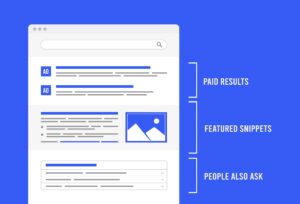
Back-to-basics with PPC advertising fundamentals

Once you get into the world of PPC advertising and start to get to grips with ROAS (return on ad spend), CPC (cost-per-click) and conversion, it’s hard to believe that it could have had such a large impact on marketing only in the last 30+ years. Nevertheless, PPC has become a fundamental aspect of companies’ advertising strategies and it looks like it’s here to stay.
What is PPC advertising?
If you’re familiar with the digital market, you might have already heard terms like paid and organic in relation to the sort of traffic your site generates. The latter refers to visitors who find your website through high rankings or guest posting as part of an effective SEO strategy. You don’t pay for impressions with organic traffic, rather you make it onto their radar through intelligent site optimisation.
By contrast, paid traffic is used by B2B and B2C businesses to drive leads and ensure a return on your investment by converting leads into paying customers through pay per click advertising. This means that every time a user clicks on your ad you’ll pay a certain amount, but with effective marketing you should also see an increase in your sales from the initial click.
As part of the wider field of paid search marketing, PPC shares a stage with display advertising, remarketing, Google Shopping and social media advertising.
Some of the largest PPC platforms are run by brands that you’ll definitely have heard of if you managed to make it to this page. While Google Ads is the most popular, other platforms like Amazon ads and Microsoft Advertising are also used by millions of people. Similarly, many social media channels like Instagram and Facebook have also staked their claim in the advertising game.
PPC Lead, George on why he recommends this type of marketing:

“PPC is the highest intent form of digital marketing, users are actively searching for your product or service, so you know their is immediate desire for what you offer. PPC is a perfect validation of if your offer matches up to the consumers desire. PPC can actively stress test if your business is viable or not.”
PPC that works for you
In order to create a successful PPC campaign, you need to develop a strategy which prioritises your target audience based on customer intent and ad positionality. This will vary from business to business depending on location, the types of products and services that you sell, and how much you have to dedicate to your PPC budget in order to achieve your business goals.
In order to determine which strategy is best for your brand, here’s a basic overview of the most common PPC techniques to give you an idea of your business’s advertising potential.
Display Network Adverts

Already Google Ads – by far the most popular PPC platform worldwide – has a feature called Smart Display campaigns that makes use of automated bidding, creatives, and targeting. This means that Google recognises when your ad is likely to generate the most engagement from the most potentially-profitable audience and spends your budget accordingly.
With display network adverts, you can also choose the level of AI integration you prefer in your ads to ensure the consistent presentation of visually engaging ads on the Google Display Network (GDN) without you having to worry about the complex variables of display and advertising.
These ads are usually identifiable by the ‘AdSense’ logo, meaning the advertiser has specified where they want their ad to be shown. The Google Display Network does this by analysing a page’s existing content and inserting your ad where it will be the most relevant and generate the most impressions. This is often referred to as CPM (cost-per-thousand) because you pay for an ad placement all in one go rather than for each individual click at a time.
Search Network Adverts

By far the most popular of the PPC techniques, Search Network Adverts appear on the Google Search Network near similar adverts which make use of related terms or keywords. This type of advert includes text ads, dynamic search ads, responsive search ads, and call-only ads. Extensions or assets often accompany these ads which allow a user to contact the business or find out where it is without having to carry out another search, increasing the likelihood of CTR and conversion. Search Network Ads also include shopping ads and image and video ads.
These paid links tend to appear at the top of the search results page or in the right-hand sidebar, and usually consist of 95 characters or less. Each click will usually cost a set amount which may change spending on how popular your keywords are.
Typically, after competitors have bid on a keyword, the ad’s position or ranking is calculated by an algorithm which takes into account the quality score as well as a range of other factors like ad relevance, landing page experience, and expected CTR.
Social media advertising

Whether you’re always glued to your phone or don’t know the difference between Chapsnat and Tik-Tak-Toe, it’s no secret that social media platforms are a gold mine for advertising when it comes to generating customer engagement and increasing CTRs.
Platforms like Facebook host paid advertising in the form of sponsored content directly in users’ news feeds, as well as boosted posts and regular adverts to accompany that girl from your high school’s new baby announcement. Because of the domestic nature of Facebook, it’s useful for B2C businesses because it resonates with people and is a good way of building up audience segments.
By contrast, Linkedin is known for its presentation of business opportunities. The site’s filters make it possible for businesses to target their ads to certain asset groups based on location, job title and relevant skills.
Since it was launched in 2005, YouTube has seen an incremental growth as an advertising platform with the rise in video ads which precede the video users have searched for. This is known as pre-roll.
And lastly Twitter, which needless to say has undergone quite a few changes in recent times. Due to the fast paced nature of this social media platform, advertisers need to get in quick in order to gain impressions on their ads.
Business benefitting basics
Before you get lost in the CPA, KPI and RDA of it all, and even if you’re happy to hire a PPC expert to help you expand your business, it’s a good idea to have at least a basic understanding of PPC advertising. This will enable you to use it to your advantage to optimise your ad campaigns for maximum ROI.
Hopefully this good has given you a brief insight into the main types of PPC so that you have more of an idea of how to make paid advertising work for you and your business.
FAQs
Answered by Callum Leonard
How long do PPC campaigns normally run?
As long as PPC activity is working for you, it depends on the goals of the business. If you think that your PPC performance isn’t worth your money, then you are doing your campaigns wrong.
Which type of business is PPC suitable for?
PPC can be suitable for a lot of business types. For generic companies with a large search volume, PPC can be really useful in helping your brand get noticed.
Can I run a PPC campaign with no expert help?
Yes, you can, but this isn’t recommended because there are so many variables. You are not likely to get the best out of your performance if you yourself are not a PPC expert.